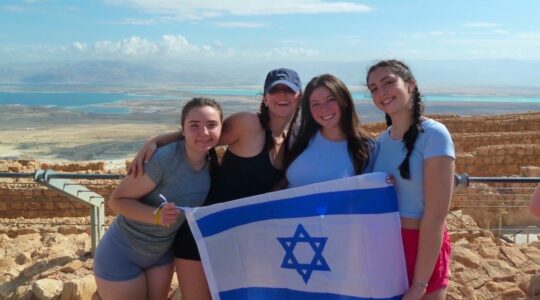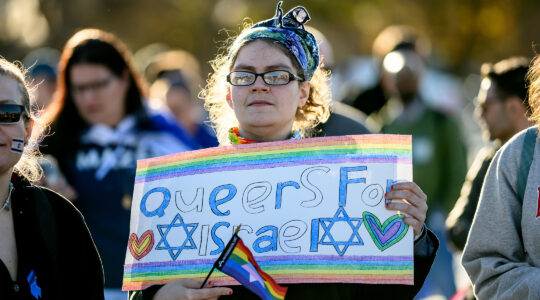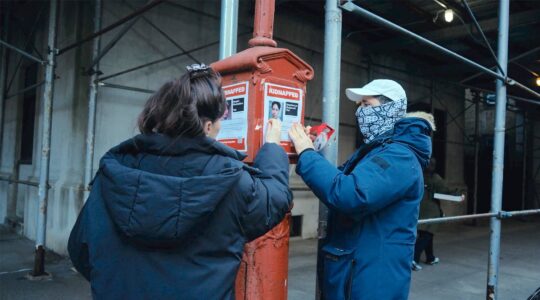
DeLeon, an Indie rock band shown performing in the summer of 2008 at Celebrate Brooklyn, features music with 15th-century Spanish influences. (Jori Klein)
HOBOKEN, N.J. (JTA) — Daniel Saks’ crazy black curls bounce on stage with him to the wiry, deafening sound of guitars, horns and drums as the front man for DeLeon — an indie rock band with 15th century Spanish influences infused with cadences of the ancient Sephardic tradition — belts out plaintive tunes in English, Hebrew, Spanish and Ladino.
For the most part, the 150 twenty-something hipsters dancing to DeLeon’s music at Maxwell’s lounge, 20 minutes from Manhattan, have no idea what the songs mean. It doesn’t seem to matter.
“It wasn’t a Ladino-fluent crowd,” Saks jokes after the show, referring to the Judeo-Spanish language from the Middle Ages. “I think people can get past the language barrier. In a place like New York City, we’re acclimated to hearing music in foreign languages.”
Saks grew up near Washington listening to Sephardic music played by his mother, whose family lived in Italy for centuries after the expulsion from Spain before coming to the United States.
Years later he would name his band after his great-grandfather Giorgio DeLeon and philosopher Moses DeLeon. With its haunting melodies and the Spanish timeless themes of love and God and murder, he thought the music “held up well, better than most songs.” He knew there were plenty of people recording traditional music, but “I thought I could bring it to my peers and bring new light to them.”
DeLeon is part of a new crop of modern Jewish artists drawing on their Sephardic roots — from Spain and Portugal, to Morocco, Iran and Syria, to India and Greece. Many of those Jewish communities, although not all, were created by Jews who left Spain following the Inquisition, when they were ordered to convert or leave the country by July 31, 1492 (Tisha B’Av of that year).
Now, more than five centuries later, dozens of musicians, writers, poets, playwrights, filmmakers, historians, educators and chefs are reclaiming that culture to create a veritable Sephardic renaissance.
Many artists mine Sephardic culture because they want to popularize a lesser-known Jewish heritage.
“People who came from Poland stick together, and they are not so interested in the people who come from Morocco or Spain,” says Nathalie Soussana, arranger of “Songs From The Garden Of Eden: Jewish Lullabies And Nursery Rhymes,” a book and CD of songs in Hebrew, Arabic and Spanish, including Y’aommi Yamali, an Algerian lullaby in Arabic whose words mean “King of the Home/May God touch you and lift up your soul.”
Soussana wanted something that reflected her own mottled family — originally from Morocco, living in France, with an uncle with a wife from Turkey, an aunt married to an Ashkenazi, family members in Israel.
“I think that it’s like that for a lot of Jewish families,” she says.
One might not know that from seeing the history of Jewish culture in America.
“Jewishness has tacitly been assumed to be synonymous with Germanic or Eastern European descent,” Aviva Ben Ur writes in the new book “Sephardic Jews in America: A Diasporic History” (New York University Press, 2009). “What began at the turn of the 20th century as denial of shared ethnicity and religion (whereby Ashkenazim failed to recognize Sephardim as fellow Jews) continues today in textbooks, articles, documentaries, films and popular awareness. More often than not, Sephardic Jews are simply absent from any sort of portrayal of the American Jewish community.”
Ur prefers the term non-Ashkenazic Jews, dividing those called Sephardim into three groups: Sephardi Jews (Spanish and Portuguese-speaking Jews of Western Europe and Ladino-speaking Jews of the Ottoman empire); Mizrahi Jews (Arabic-speaking Jews native to the Middle East and Western Asia); and Romaniotes (Greek-speaking Jews native to the Byzantine Empire).
“In America there was ‘Fiddler on the Roof’ and gefilte fish and Orthodox and Conservative and Reform Judaism,” says Rabbi Daniel Bouskila of Sephardic Temple Tifereth Israel in Los Angeles. The various non-Ashkenazic groups “had every desire to be American when it came to living their lives, but in terms of their Judaism, they didn’t have much interest in assimilating into the American Jewish community.”
That’s why Sephardim formed their own synagogues like Tifereth Israel (founded by a small group of Sephardic, Ladino-speaking immigrants in 1920) or more recently the Sephardic Cultural Center in Scottsdale, Ariz., both with congregants from communities such as Iraq, Iran, Morocco, Algeria, Tunisia, Libya, Egypt, Syria, Lebanon, Iran, Yemen, Brazil and Israel.
Bouskila believes that a Sephardic resurgence in Israel has fueled a wider movement in America and around the world.
“Once upon a time there was one definition of being Israeli — the prototypical Sabra being from Europe had blond hair and listened to a particular kind of music — I think that’s changed in Israel,” he says, citing the pop stars Sarit Hadad, Eyal Golan and Israel’s first “Idol” winner, Maya Bouskila (no relation). “There’s a unique sense of cultural identity through music and even names” — people don’t Hebraicize their Sephardic names as much.
It has “spilled over” to America, Bouskila adds.
“I think people feel more secure in their identity today than they did a long time ago,” he says.
For some artists, exploring Sephardic culture is a way to explore their own Jewish identity. Sephardim account for 3 percent to 4 percent of the Jewish population in the United States.
“The communities that people lived in before were so much more closed, and you were only defined by one thing,” says Vanessa Paloma, a singer and scholar who specializes in Sephardic women’s songs like “Mose de Salio de Misrayim,” a Ladino song about the burning bush and Moses’ journey from Egypt, which women would sing at Passover.
For Paloma, being American means having many different identities — actor, writer, yogi, etc.
“It’s like we’re hungry for some kind of deeper meaning and these roots are where we came from,” she says.
Now Paloma is living in Morocco, where she can investigate her past.
“What did my grandmother sing? What kind of smells did she smell?” she wonders. “If I know more about that, I know more about my ancestors and know more about myself.”
Others want to preserve a culture they fear might be lost.
“I just thought about writing my family story — it’s a very eccentric, eclectic family,” novelist Gina Nahai says of the beginning of her journey writing fiction based on the Persian Jewish community in Iran and Los Angeles. When she began her seven years of research for her first novel, “Cry of the Peacock,” she saw that there was barely anything written about the community or its history.
Iranian Jews make up “the oldest Jewish community in the Diaspora and no one had recorded their stories,” she says. “And it didn’t look like people were going to survive.”
Many artists may be teaching their culture to their own people.
Jennifer Abadi, author of the cookbook-memoir “Fistful of Lentils: Syrian-Jewish Recipes from Grandma Fritzie’s Kitchen” (Harvard Common Press 2007), was surprised to find that many students in her classes were Syrian women who grew up eating food prepared by their mothers and housekeepers but had not learned to cook it.
“All of a sudden they get married to Syrian men, and it’s expected [for them to cook Syrian food] and they have to go to their mothers and aunts,” Abadi says, adding later, “so the book does provide a service.” She says her audience also is Ashkenazi women “who like what they consider ‘better’ Jewish food.”
That’s why many artists are mining Sephardic culture — because they like it. Majadrah (rice with lentils) might be better than kugel, and DeLeon “might be cooler than klezmer,” jokes Jacob Harris, the chief operating officer of JDub records, which produces both DeLeon and “Songs From The Garden Of Eden.”
JDub wasn’t seeking out Sephardic artists per se, Harris says, but wanted “to promote authentic Jewish culture within the mainstream.” And the mainstream likes world music.
“I don’t think it’s an accident that it’s become so popular now — we are becoming more global, seeing Jewish history in a broader way,” says Ilan Stavans, editor of “The Schocken Book of Modern Sephardic Literature” (Schocken, 2005), an anthology that includes fiction, memoirs, essays and poetry from 28 writers over 150 years, including a short story by Cuban-Jewish writer Ruth Behar titled “Never Marry a Man Who Doesn’t Beat You.”
“The Jewish community is increasingly heterogeneous, not only politically but ethnically. People come from different parts of the world through immigration and mixed marriages, and they are pushing the collective identity in different ways,” Stavans says, including contributions from Asian and Hispanic cultures. “The need to understand the Sephardim is to understand a very important part of Jewish history.”
No longer does Jewish identity have to be “the standard flagpoles of Israel, the Holocaust and the shtetl,” he says.
Yet even the term “Sephardic Renaissance” can be seen as Ashkenazi-centric; after all, these cultures have been flourishing for centuries, even if invisible to Ashkenazim.
“We live our religion — there is no resurgence,” says Sheila Schweky, the program chair for the Sephardic Community Center in Brooklyn, N.Y., a JCC-like institution that serves 50,000 to 70,000 Jews — mostly Syrian, but also Egyptian, Iraqi, Moroccan and others.
Schweky cites the strong family ties and tight-knit community for preserving the Syrian Jewish heritage.
“As far as our traditions and customs, they’re basically the same as when our fathers came here,” she says, so the idea of a “renaissance” doesn’t apply. “We don’t turn around and say we have to teach our children our heritage — they live it.”
Many tight-knit Sephardic communities that have thrived, but remained nearly invisible to the rest of the world, are learning that art can sometimes show less than positive portrayals. The Syrian Jewish community, for example, was not happy with David Adjmi’s “Stunning,” a recent Off-Off-Broadway play that The New York Times called “a stinging portrait of an insular Syrian Jewish community in contemporary Brooklyn.”
“Smaller communities think that everyone is going to judge everyone by that one play,” the novelist Nahai says. “People overreact — it’s not like every time you meet a Greek person you think of ‘My Big Fat Greek Wedding.’ ”
On the one hand, people like seeing their community portrayed.
“So many young people write to me and tell me finally I can understand why my family is the way they are,” Nahai says.
Others, however, become upset at some of the issues she raises, such as the treatment of women in the Persian Jewish community or how the rabbis were not always just.
“All novelists need to tell the truth. It doesn’t mean it’s the only reality, it doesn’t mean I ‘m trying to capture the entire population,” Nahai says. “Telling the truth is the only thing I have a responsibility to do. The rest a publicist needs to do.”
Perhaps the Sephardic communities will become accustomed to the spotlight — and the good and bad lights shone on them.
“It’s interesting that this is happening now,” Stavans says. “It’s because the Ashkenazi community is really solid, and it can look into other aspects of Jewish life without feeling threatened.”
What they are seeing from Sephardic culture, in all its multiplicity and history, is that Sephardim “are more ethnic and more attractive in close-knit families that traveled across time and kept their identity,” he says.
“At a time when it’s very easy to lose one’s identity, you admire their ability to keep their identity across time and space,” Stavans says. “You feel an allure to Sephardic culture.”
JTA has documented Jewish history in real-time for over a century. Keep our journalism strong by joining us in supporting independent, award-winning reporting.





